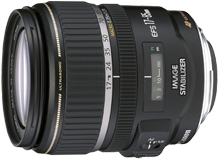
Canon EF-S 17-85/4-5.6 IS USM Lens Review |
Canon EF-S 17-85/4-5.6 IS USM Review
ConclusionsThe EF-S 17-85/4-5.6 IS USM is a very useful lens. Sharpness is generally good in the center, with some softening in the corners, especially at wide aperture. Pretty normal performance for this class of lens and quite comparable to the EF 28-135/3.5-5.6 IS. There is some lateral chromatic aberration, especially at the wide end of the zoom range, but it's not excessive. There's visible barrel distortion at 17mm which could be a problem if you were shooting subjects with rectangular lines such as framed artwork or buildings and didn't correct for it. However since this is a lens which only fits digital cameras and since correction of barrel distortion is a simple process in almost any image editor, geometric distortion isn't the problem it would be if you were, say, shooting slides for projection. The Canon EF-S 17-85/3.5-5.6 IS USM seems like an ideal general purpose lens. It covers the focal lengths most frequently used by most photographers (27mm wideangle to 136mm telephoto in full frame 35mm terms). On top of this it has 2nd generation Image Stabilization which is very effective and can give you up to 3 stops of extra "handholdability". This partly makes up for it's relatively slow speed at the longer end of its range. Coupled with an EF 70-300/4-5.6 IS USM (see full 70-300 review here) it would give a photographer a very wide range, without much focal length overlap between the lenses, and with 2nd generation IS on both lenses! The EF-S 18-55/3.5-5.6 (see full 18-55 review here)covers much of the same range as the EF-S 17-85 and it's a lot cheaper. However, it lacks IS, it doesn't have USM with full time manual focusing, it's construction (all plastic including the lens mount) leaves something to be desired and it has a rotating front element. Optically, it's pretty decent for the price, but overall it really can't compete with the EF-S 17-85 in terms of usefulness or quality of construction. It's also not quite as wide at the wide end and significantly shorter at the telephoto end of the range, plus it leaves a gap between 55mm and 70mm if coupled with a 70-300 zoom and you'd have to switch lenses more often than you would with the 17-85. The EF-S 18-55 is a good lens for a photographer on a really tight budget, but the EF-S 17-85 is clearly better. Some might consider the EF 17-40/4L as an alternative. Though it's an "L" series lens and (from tests other than my own) seems to be a little sharper then the EF-S 17-85 at the edges of the frame and wide open, it does have a significantly smaller focal length range (making lens swapping more frequent), plus though it's 2/3 stop faster at 40mm it lacks IS, so it's less "handholdable". For the critical professional who needs both durability and optimum performance wide open it can be a good choice, but for the average amateur I think the EF-S 17-85/4-5.6 IS makes more sense - and it's about $175 cheaper too! If you already have an EF-S 10-22/3.4-4.5 USM (see full 10-22 review here), it wouldn't be unreasonable to consider adding an EF 28-135/3.5-5.6 IS USM to it rather than an EF-S 17-85. You'd increase the telephoto range from 85 to 135mm and you'd still have IS (though 1st generation, good for 2 stops, not 3). The 22-28mm gap could be a problem, but it corresponds to 35 to 45mm in full frame terms and for me that's not a critically important range. The downside is, of course, that you'd have to switch lenses when going from wideangle to normal/telephoto, something the EF-S 17-85 avoids. Given the problems of sensor dust, many photographers like to keep their lens swapping to a minimum. Overall I can certainly recommend the EF-S 17-85/4-5.6 IS USM to anyone looking for a good "all round" lens, especially if they intend to shoot mostly "hand held" and don't like frequent lens swapping. Where to BuyTake a look at Amazon.com. They're reliable, their prices are good and sometimes they offer free shipping. If you're buying the EF-S 17-85/4-5.6 IS USM you might want to look at the lens hood and a UV/protection filter. The best filter is probably the Hoya Pro-1 UV. It's Hoya's "top of the line" 12 layer multicoated, low profile, UV filter. Somewhat cheaper is the Hoya SMC (Super Multi Coated) UV filter and 95% of the time it probably works about as well.
© Copyright Bob Atkins All Rights Reserved |
|||||||||
|
|
